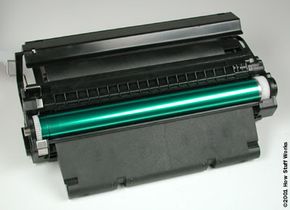Applying Toner
So how does the printer apply this toner to the electrostatic image on the drum? The powder is stored in the toner hopper, a small container built into a removable casing. The printer gathers the toner from the hopper with the developer unit. The "developer" is actually a collection of small, negatively charged magnetic beads. These beads are attached to a rotating metal roller, which moves them through the toner in the toner hopper.
Because they are negatively charged, the developer beads collect the positive toner particles as they pass through. The roller then brushes the beads past the drum assembly. The electrostatic image has a stronger negative charge than the developer beads, so the drum pulls the toner particles away.
Advertisement
The drum then moves over the paper, which has an even stronger charge and so grabs the toner. After collecting the toner, the paper is immediately discharged by the detac corona wire. At this point, the only thing keeping the toner on the page is gravity -- if you were to blow on the page, you would completely lose the image. The page must pass through the fuser to affix the toner. The fuser rollers are heated by internal quartz tube lamps, so the plastic in the toner melts as it passes through.
But what keeps the toner from collecting on the fuser rolls, rather than sticking to the page? To keep this from happening, the fuser rolls must be coated with Teflon, the same non-stick material that keeps your breakfast from sticking to the bottom of the frying pan.
